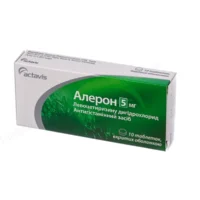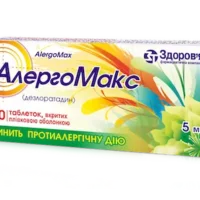Description
Fencarol (Hifenadina Hydrochloride) Tablets 10 mg. №20
Ingredients
Active Ingredient: Hifenadina Hydrochloride 10 mg per tablet.
Mechanism of Action
Fencarol contains Hifenadina Hydrochloride, an antihistamine that functions by antagonizing histamine receptors. By inhibiting the effects of histamine, Fencarol alleviates symptoms associated with allergic reactions.
Pharmacological Properties
Fencarol exerts its therapeutic effects by selectively blocking the H1 histamine receptors, thereby preventing histamine-induced symptoms such as nasal congestion, itching, and sneezing.
Indications for Use
Indications: Fencarol tablets are indicated for the management of allergic rhinitis symptoms, including sneezing, nasal congestion, rhinorrhea, and ocular symptoms like itching and watering eyes.
Contraindications
Contraindications: Fencarol tablets should not be administered to individuals with a known hypersensitivity to Hifenadina Hydrochloride or any other components of the formulation.
Side Effects
Common side effects of Fencarol may include drowsiness, dry mouth, blurred vision, and gastrointestinal disturbances. Rare but severe adverse reactions may include palpitations, urinary retention, and allergic reactions.
Usage Instructions
Dosage: The recommended dose is one tablet orally once daily. It is crucial to adhere to the prescribed dosage and not exceed the recommended amount to avoid adverse effects.
Benefits Compared to Analogues
Fencarol offers superior efficacy in managing allergic rhinitis symptoms compared to first-generation antihistamines due to its reduced sedative effects and improved safety profile.
Suitable Patient Groups
Fencarol is suitable for adults and children above a certain age, as determined by a healthcare provider. Special caution is advised when prescribing to elderly individuals due to the potential for increased susceptibility to side effects.
Storage and Shelf Life
Store Fencarol tablets in a cool, dry place away from direct sunlight. Ensure proper sealing of the packaging to protect the tablets from moisture. Check the expiration date on the packaging and do not use expired tablets.
Packaging Description
Fencarol tablets are packed in blister packs to maintain product integrity and protect from external factors. Each pack contains 20 tablets, individually sealed for convenience and hygiene.
Clinical Evidence and Proven Effectiveness
Fencarol (Hifenadina Hydrochloride) has been extensively studied in clinical trials, demonstrating its efficacy in alleviating allergic rhinitis symptoms. Research has shown significant improvements in nasal congestion, sneezing, and itching compared to a placebo, supporting its use in clinical practice.





